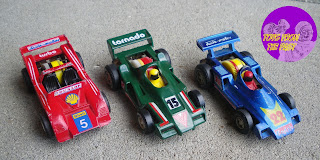This is the
second MOTU accessory I show, so most about these is already said in the entry#94. This time I can expand the previous article with some pictures of the
Megalaser, including pictures of this accessory MOC (Mint On Card).
The first
three accessories we mentioned (Jet Sled, Stilt Stalkers and Megalaser) were
sold carded, just like the figures, in packages of the same size and colours (these that were released in the 6th wave were sold boxed). The
bubble was obviously different, and adapted to each item. This is the only
collectable I own “carded” from the Masters of the Universe line and I have it
also loose from my childhood days. My father bought it for me some time by the
end of the 80s.
The Megalaser comes in four parts: a two pieces red armour, a black belt that also attaches to the armour and the gun, that fits in a peg of the armor, over the right shoulder. The next few pictures should show that clearly.
Since I won’t
be able to show any carded figure, maybe it is interesting to pay attention to
the front of the package. It has the MOTU logo in blue over a red background of
exploding stones. The new figures/accs. in each wave carried the word “new!” at
the upper left corner. This package seem to be the American version, and is
therefore written in English. It is very important to pay attention to the
subtitle of each figure or accessory, that you know what you were buying and
which affiliation does it have. This was specially helpful for parents, since
the names are more difficult to remember than the descriptions. Parents are
more likely to remember that they once bough the “Human Periscope” as “Mekaneck”,
mostly when Mekaneck is mixed up with other figures with similar names and
similar colours and looks.
 |
| Front of Megalaser's card |
The
Megalaser is a “Heroic wind up beam blaster”, for a child this name sounds
great, although it really describes its mechanism. The Megalaser works winding
up the small blue wheel at the top of the gun, what makes the other blue parts
(two cannons plus two edges) move.
 |
| Back of Megalaser's card |
 |
| Megalaser's illustration (cardback, detail) |
 |
| Megalaser's instructions (cardback, detail) |
 |
| Megalaser's catalogue (cardback, detail) |
At the
backcard, there’s a great illustration, which is unique to each reference,
short instructions about the features of the figure/accessory, and a short
catalogue of other references available at the same time.
The
dioramas show Clamp Champ (our “official” accessory tester) with Roboto in a
jungle expedition. Both figures and the Megalaser make a team with great firepower.
FACTS and FIGURES:
- Name: MEGALASER (Ref. 2083)
- Toy Line: Masters of the Universe (Wave 5)
- Year: 1986
- Company: Mattel (U.S.A.)
- Size of the figures: approx. 16 cm























+%5B1600x1200%5D.jpg)

+%5B1600x1200%5D.jpg)

+%5B1600x1200%5D.JPG)
+%5B1600x1200%5D.JPG)










%2B(Copiar).jpg)
%2B(Copiar).jpg)
%2B(Copiar).jpg)
%2B(Copiar).jpg)






















